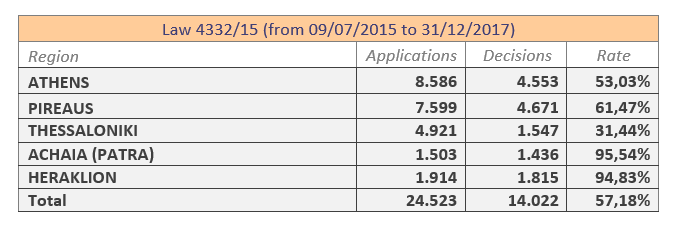Course of Greek citizenship applications | Statistics until 2017
Based on the annual report of the newly created Special Secretariat of Citizenship, the number of positive decisions on the acquisition of Greek citizenship for the year 2017 was 33.718. More specifically, we see that 73.51% of the positive decisions concern applications based on birth/school attendance in Greece. The largest percentage of these (92.07%) concerns applications from citizens of Albanian origin. As far as naturalization is concerned, it is at a much lower level (10.33%), with the higher percentage (60.78%) owned also by applications made from citizens of Albanian origin.
It is noted that this is the first comprehensive annual report posted by the Ministry of Interior.
On the charts below, you can find further quantitative data that Generation 2.0 RED requested from the Ministry of Interior regarding pending naturalization requests, as well as the progress of applications for citizenship based on birth/school attendance.
Pending naturalization applications
The quantitative data generally confirm a downward trend in the process of acquiring Greek citizenship by naturalization in 2017. Specifically, although in 2016 the naturalization decisions more than doubled compared to those of 2015, during 2017 not only did they not go up, but they dropped in absolute numbers by 141 decisions, as shown by the annual data of the Ministry of Interior here.
Also, according to data provided by the Ministry of Interior to Generation 2.0 RED, the number of pending applications for naturalization has increased by 6%, compared to the first half of 2017, mainly due to the services of Attica.

Law 4332/15 (Second Generation)
Since the implementation of Law 4332/15, Generation 2.0 RED has requested and received from the Ministry of Interior the quantitative data on the applications and the positive decisions under the law 4332/15 (Greek citizenship based on birth and attendance) here.
However, the question about the course of applications for Greek citizenship in different regions of Greece remained unanswered until now, and questions are being raised on the existence of “2-speed” regions. For this reason, the figures this time are shown not only on the level of Athens and the rest of Greece, but in relation to the 5 most populous municipalities in Greece (based on the 2011 census), from the beginning of the implementation of the law until the end of 2017, based on the data requested by the Ministry of the Interior.
The chart refers to the period from the implementation of the law 4332/15 until the end of 2017, ie 9/7/2015 – 31/12/2017. We clarify that the numbers also include the re-submission of pending applications from the previous law (3838/2010).
The decision / application rates show an expected trend of increased percentage of decisions for Greek citizenship in regions where the applications are comparatively fewer, ie in Achaia and Heraklion, Crete. The latter is well-known to us for its speed of application processing. The exception is the Thessaloniki service (with local jurisdiction in the regional section of Thessaloniki), where we see that, while the number of applications received is almost half of the respective service in Athens, the percentage of decisions issued is much lower.
These rates confirm testimonies we have received from time to time as an organization, from people of migrant origins living in the Thessaloniki region, regarding the long delay of their applications. According to these testimonies, there are applications that have been filed even 2 years ago and yet they have not yet been processed.

According to the Thessaloniki service, at the moment (March 2018) they examine requests submitted in 2016 on birth/attendance and in 2012 on attendance.
Our organization had already raised the issue on the Special Secretariat of Citizenship, when we had accepted the above-mentioned testimonies. From the data we received from the Ministry of the Interior itself, we are even more concerned about the existence of “multi-speed” regions with a practical effect of a largely heterogeneous course of applications.

 Ελληνικά
Ελληνικά

